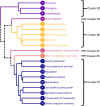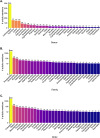Spatial and temporal trends in dung beetle research
- PMID: 39995986
- PMCID: PMC11849510
- DOI: 10.7717/peerj.18907
Spatial and temporal trends in dung beetle research
Abstract
Dung beetles are one of the most charismatic animal taxa. Their familiarity as ecosystem service providers is clear, but they also play a range of roles in a variety of different ecosystems worldwide. Here, we give an overview of the current state of dung beetle research and the changes in the prevalence of topics in a collated corpus of 4,145 peer-reviewed articles of dung beetle research, spanning from 1930 until 2024. We used a range of text-analysis tools, including topic modelling, to assess how the peer-reviewed literature on dung beetles has changed over this period. Most of the literature is split into three distinct, but related discourses-the agri/biological topics, the ecological topics, and the taxonomic topics. Publications on the 'effect of veterinary chemicals' and 'nesting behaviour' showed the largest drop over time, whereas articles relating to 'ecosystem function' had a meteoric rise from a low presence before the 2000's to being the most prevelant topic of dung beetle research in the last two decades. Research into dung beetles is global, but is dominated by Europe and North America. However, the research from South America, Africa, and Australia ranges wider in topics. Research in temperate and tropical mixed forests, as well as grasslands, savanna and shrublands dominated the corpus, as would be expected from a group of species directly associated with large mammals. Our assessment of dung beetle research comes when ecosystem service provision is becoming more important and more dominant in the literature globally. This review therefore should be of direct interest to dung beetle researchers, as well as researchers working in agricultural, ecological, and taxonomic arenas globally. Research worldwide and across agri/biological, ecological, and taxonomic discourses is imperative for a continued understanding of how dung beetles and their ecosystem services are modified across rapidly changing natural and agricultural landscapes.
Keywords: Aphodiinae; Corpus; Dung beetle; Ecosystem services; Geotrupinae; Scarabaeinae; Subject topic modelling.
© 2025 Hemmings et al.
Conflict of interest statement
Nigel Andrew is an Academic Editor for PeerJ.
Figures









References
-
- Andresen E, Laurance SGW. Possible indirect effects of mammal hunting on dung beetle assemblages in Panama. Biotropica. 2007;39(1):141–146. doi: 10.1111/j.1744-7429.2006.00239.x. - DOI
-
- Andrew NR, Evans MJ. Trends in Austral Ecology publications 2021 and 2022. Austral Ecology. 2023;48(6):1049–1055. doi: 10.1111/aec.13386. - DOI
-
- Andrew NR, Evans MJ, Svejcar L, Prendegast K, Mata L, Gibb H, Stone MJ, Barton PS. What‘s hot and what’s not—identifying publication trends in insect ecology. Austral Ecology. 2022;47(1):5–16. doi: 10.1111/aec.13052. - DOI
-
- Ballari SA, Roulier C, Nielsen EA, Pizarro JC, Anderson CB. A review of ecological restoration research in the global south and north to promote knowledge dialogue. Conservation and Society. 2020;18(3):298–310. doi: 10.4103/cs.cs_19_91. - DOI
Publication types
MeSH terms
Associated data
LinkOut - more resources
Full Text Sources

